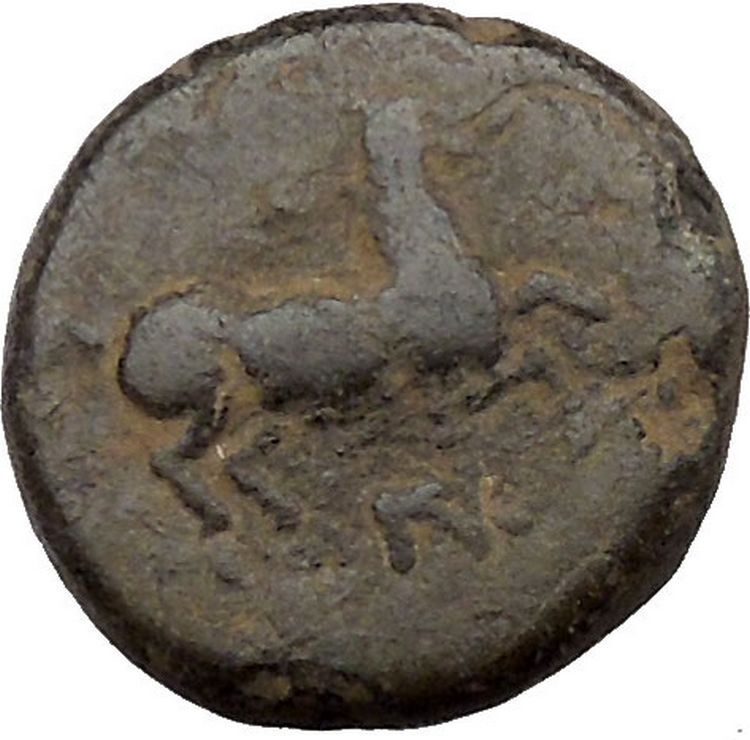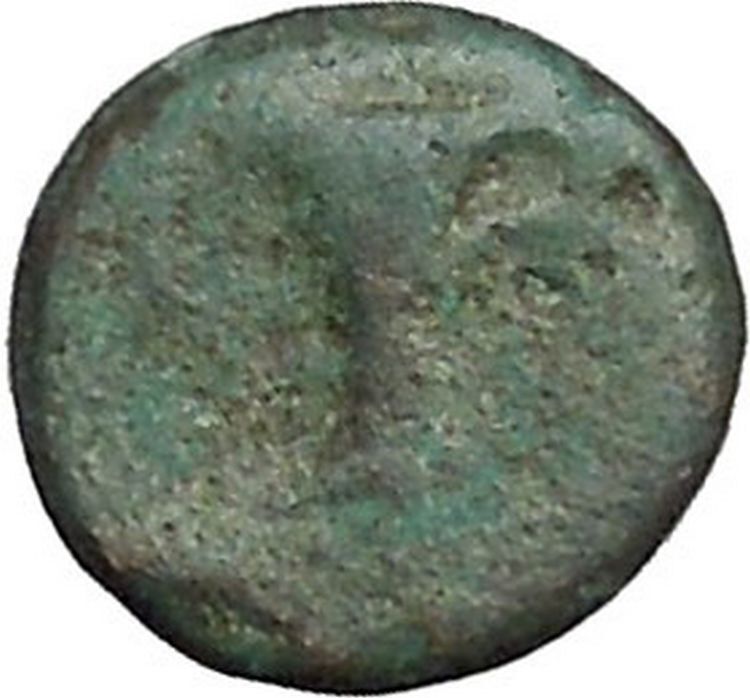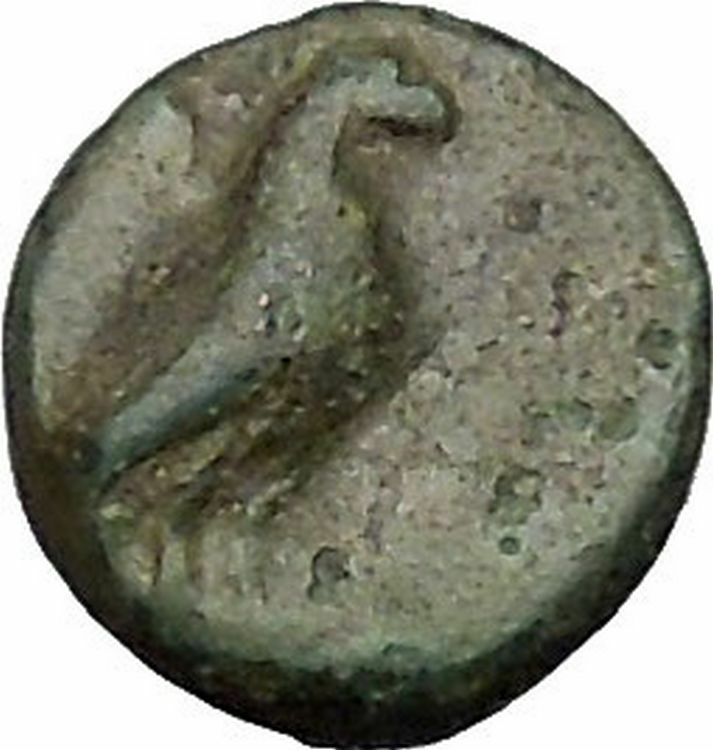|
Greek city of Menainon in Sicily
Bronze Tetras 20mm (4.14 grams) Struck circa 175-125 B.C.
Reference: Calciati III pg. 183, 1; SNG ANS 292 variety; RARE
Laureate and draped bust of Zeus Serapis right; lotus flower in hair; E behind.
MENAINΩN, Nike driving galloping biga right.
Founded in 459 B.C., Menainon was the subject to Syracuse for much
of its history down to the time of the Roman conquest at the end of the 3rd
Century.
You are bidding on the exact
item pictured, provided with a Certificate of Authenticity and Lifetime
Guarantee of Authenticity.
Serapis is a Graeco-Egyptian god. Serapis was devised during the 3rd
century BC on the orders of
Ptolemy I of Egypt
as a means to unify the
Greeks and Egyptians in his realm. The god was depicted as Greek in appearance,
but with Egyptian trappings, and combined iconography from a great many cults,
signifying both abundance and resurrection. A
serapeum
(Greek serapeion) was any
temple or religious precinct devoted to Serapis. The
cultus
of Serapis was spread as a matter of
deliberate policy by the
Ptolemaic kings
, who also built an immense
Serapeum in Alexandria.

Serapis continued to increase in popularity during the
Roman period
, often replacing
Osiris
as the consort of
Isis in temples outside Egypt. In 389, a mob led by the
Patriarch
Theophilus of Alexandria
destroyed the
Alexandrian Serapeum, but the cult survived until all forms of religion other
than
Nicene Christianity
were suppressed or
abolished under
Theodosius I
in 391.
About the god
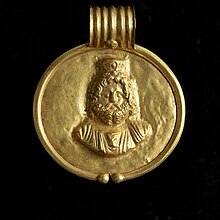
This pendant bearing Serapis’s likeness would have been worn by a
member of elite Egyptian society.
Walters Art Museum
,
Baltimore
.
“Serapis” is the only form used in Latin, but both
Ancient Greek
:
Σάραπις Sárapis and
Ancient Greek
:
Σέραπις Sérapis appear in Greek, as well as
Ancient Greek
:
Σαραπo Serapo in Bactrian.
His most renowned temple was the
Serapeum of Alexandria
. Under
Ptolemy Soter
, efforts were made to integrate
Egyptian religion with that of their Hellenic rulers. Ptolemy’s policy was to
find a deity that should win the reverence alike of both groups, despite the
curses of the Egyptian priests against the gods of the previous foreign rulers
(e.g.
Set
, who was lauded by the
Hyksos
).
Alexander the Great
had attempted to use
Amun for this purpose, but he was more prominent in
Upper Egypt
, and not as popular with those in
Lower Egypt
, where the Greeks had stronger
influence. The Greeks had little respect for animal-headed figures, and so a
Greek-style
anthropomorphic
statue was chosen as the
idol
, and proclaimed as the equivalent of the
highly popular
Apis
. It was named Aser-hapi (i.e.
Osiris-Apis), which became Serapis, and was said to be
Osiris
in full, rather than just his
Ka
(life force).
History
The earliest mention of a Serapis is in the disputed death scene of Alexander
(323 BC). Here, Serapis has a temple at
Babylon
, and is of such importance that he
alone is named as being consulted on behalf of the dying king. His presence in
Babylon would radically alter perceptions of the mythologies of this era: the
unconnected Babylonian god Ea (Enki)
was titled Serapsi, meaning ‘king of the deep’, and it is possible this
Serapis is the one referred to in the diaries. The significance of this Serapsi
in the Hellenic psyche, due to its involvement in Alexander’s death, may have
also contributed to the choice of Osiris-Apis as the chief Ptolemaic god.
According to Plutarch
, Ptolemy stole the
cult statue
from
Sinope
, having been instructed in a dream by
the “unknown
god” to bring the statue to
Alexandria
, where the statue was pronounced to
be Serapis by two religious experts. One of the experts was of the
Eumolpidae
, the ancient family from whose
members the hierophant
of the
Eleusinian Mysteries
had been chosen since
before history, and the other was the scholarly Egyptian priest
Manetho
, which gave weight to the judgement
both for the Egyptians
and the Greeks.
Plutarch may not be correct, however, as some Egyptologists allege that the
Sinope in the tale is really the hill of Sinopeion, a name given to the site of
the already existing
Serapeum
at
Memphis
. Also, according to
Tacitus
, Serapis (i.e., Apis explicitly
identified as Osiris in full) had been the god of the village of
Rhakotis
before it expanded into the great
capital of Alexandria.

High Clerk in the Cult of Serapis,
Altes Museum
,
Berlin
The statue suitably depicted a figure resembling
Hades
or
Pluto
, both being kings of the Greek
underworld
, and was shown enthroned with the
modius
, a basket/grain-measure, on his head,
since it was a Greek
symbol
for the land of the dead. He also held a
sceptre
in his hand indicating his rulership,
with Cerberus
, gatekeeper of the underworld, resting
at his feet, and it also had what appeared to be a
serpent
at its base, fitting the Egyptian
symbol of rulership, the
uraeus
.
With his (i.e. Osiris’s) wife
Isis, and their son
Horus
(in the form of
Harpocrates
), Serapis won an important place in
the
Greek world
. In his Description of Greece,
Pausanias notes two Serapeia on the slopes of
Acrocorinth
, above the rebuilt Roman city of
Corinth
and one at Copae in Boeotia.
Serapis was among the
international deities
whose cult was received
and disseminated throughout the Roman Empire, with
Anubis
sometimes identified with Cerberus. At
Rome, Serapis was worshiped in the Iseum Campense, the sanctuary of Isis built
during the
Second Triumvirate
in the
Campus Martius
. The Roman cults of Isis and
Serapis gained in popularity late in the 1st century when
Vespasian
experienced events he attributed to
their miraculous agency while he was in Alexandria, where he stayed before
returning to Rome as emperor in 70. From the
Flavian Dynasty
on, Serapis was one of the
deities who might appear on imperial coinage with the reigning emperor.
The main cult at Alexandria survived until the late 4th century, when a
Christian mob destroyed the Serapeum of Alexandria
in 385, and the cult was part of the general proscription of religions other
than approved forms of Christianity under the
Theodosian decree
.
Gallery
-
Oil lamp with a bust of Serapis, flanked by a crescent moon and star
(Roman-era
Ephesus
, 100-150)
-
Statuette possibly of Serapis (but note the
herculean
club) from
Begram
,
Afghanistan
-
Head of Serapis, from a 12-foot statue found off the coast of
Alexandria
-
Head of Serapis (Roman-era Hellenistic terracotta, Staatliches
Museum Ägyptischer Kunst, Munich)
In
Greek mythology
,
Nike
was a goddess
who personified
victory
, also known as the Winged Goddess of
Victory. The Roman equivalent was
Victoria
. Depending upon the time of various
myths, she was described as the daughter of
Pallas
(Titan) and
Styx (Water) and the sister of
Kratos
(Strength),
Bia
(Force), and
Zelus
(Zeal). Nike and her siblings were close
companions of Zeus
, the dominant deity of the
Greek pantheon
. According to classical (later)
myth, Styx brought them to Zeus when

the
god was assembling allies for the
Titan War
against the older deities. Nike
assumed the role of the divine
charioteer
, a role in which she often is
portrayed in Classical Greek art. Nike flew around battlefields rewarding the
victors with glory and fame.
Nike is seen with wings in most statues and paintings. Most other winged
deities in the Greek pantheon had shed their wings by Classical times. Nike is
the goddess of strength, speed, and victory. Nike was a very close acquaintance
of Athena
, and is thought to have stood in
Athena’s outstretched hand in the statue of Athena located in the Parthenon.
Nike is one of the most commonly portrayed figures on Greek coins.
Names stemming from Nike include amongst others:
Nicholas
, Nicola, Nick, Nikolai, Nils, Klaas,
Nicole, Ike, Niki, Nikita, Nika, Niketas, and Nico.
The biga (Latin,
plural bigae) is the two-horse
chariot
as used in
ancient Rome
for sport, transportation, and
ceremonies. Other animals may replace horses in art and occasionally for actual
ceremonies. The term biga is also used by modern scholars for the similar
chariots of other
Indo-European
cultures, particularly the
two-horse chariot of the
ancient Greeks
and
Celts
. The driver of a biga is a
bigarius.
Other Latin words that distinguish chariots by the number of animals yoked as
a team are quadriga
, a four-horse chariot used for
racing and associated with the
Roman triumph
; triga, or three-horse
chariot, probably driven for ceremonies more often than racing (see
Trigarium
); and seiugis or seiuga,
the six-horse chariot, more rarely raced and requiring a high degree of skill
from the driver. The biga and quadriga are the most common types.
Two-horse chariots are a common
icon on Roman coins
; see
bigatus
, a type of
denarius
so called because it depicted a
biga. In the
iconography
of
religion
and
cosmology
, the biga represents the moon,
as the quadriga does the sun.
Greek and
Indo-European background
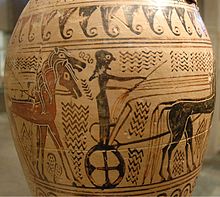
Procession of two-horses chariots on a
loutrophoros
, c. 690 BC
The earliest reference to a chariot race in
Western literature
is an event in the
funeral games
of
Patroclus
in the
Iliad
. In Homeric warfare, elite warriors
were transported to the battlefield in two-horse chariots, but fought on foot;
the chariot was then used for pursuit or flight. Most
Bronze Age
chariots uncovered by archaeology in
Peloponnesian Greece
are bigae.
The date at which chariot races were introduced at the
Olympian Games
is recorded by later sources as
680 BC, when quadrigae competed. Races on horseback were added in 648. At
Athens, two-horse chariot races were a part of athletic competitions from the
560s onward, but were still not a part of the Olympian Games. Bigae drawn
by mules competed in the 70th Olympiad (500 BC), but they were no longer part of
the games after the 84th Olympiad (444 BC). Not until 408 BC did bigae
races begin to be featured at Olympia.
In myth, the biga often functions
structurally
to create a complementary pair or
to link opposites. The chariot of
Achilles
in the
Iliad
(16.152) was drawn by two immortal
horses and a third who was mortal; at 23.295, a mare is yoked with a stallion.
The team of
Adrastos
included the immortal “superhorse”
Areion
and the mortal Kairos. A yoke of two
horses is associated with the Indo-European concept of the Heavenly Twins, one
of whom is mortal, represented among the Greeks by
Castor and Pollux
, the Dioscuri, who were known
for horsemanship.
Bigae at the races

The
consul
advances in his biga
at the
pompa circensis
[12]
(4th century,
opus sectile
from the
Basilica of Junius Bassus
)
Horse- and
chariot-races
were part of the
ludi, sacred games held during
Roman religious festivals
, from
Archaic times
. A
magistrate
who presented games was entitled to
ride in a biga. The sacral meaning of the races, though diminished over
time,[14]
was preserved by iconography in the
Circus Maximus
, Rome’s main racetrack.
Inscriptions referring to the bigarius as young suggest that a racing
driver had to gain experience with a two-horse team before graduating to a
quadriga.
Construction
A main source for the construction of racing bigae is a number of
bronze figurines found throughout the Roman Empire, a particularly detailed
example of which is held by the
British Museum
. Other sources are
reliefs
and
mosaics
. These show a lightweight frame, to
which a minimal shell of fabric or leather was lashed. The
center of gravity
was low, and the wheels were
relatively small, around 65 cm in diameter in proportion to a body 60 cm wide
and 55 cm deep, with a breastwork of about 70 cm in height. The wheels may have
been rimmed with iron, but otherwise metal fittings are kept to a minimum. The
design facilitated speed, maneuverability and stability.

Modern reenactment of a biga race
The weight of the vehicle has been estimated at 25–30 kg, with a maximum
manned weight of 100 kg. The biga is typically built with a single
draught pole for a double yoke, while two poles are used for a quadriga.
The chariot for a two-horse racing team is not thought to differ otherwise from
that drawn by a four-horse team, and so the horses of a biga pulled 50 kg
each, while those of the quadriga pulled 25 kg each.
The models or statuettes of bigae were
art objects
,
toys, or
collector’s items
. They are perhaps comparable
to the modern hobby
of
model trains
.
Mythological
and ceremonial use

The bigae of
Achilles
and
Memnon
, each drawn by one white
horse and one black horse (hydria,
575–550 BC)
In his
Etymologies
,
Isidore of Seville
explains the cosmic
symbolism of chariot racing, and notes that while the
quadriga
, or four-horse chariot, represents
the sun and its course through the four seasons, the biga represents the
moon, “because it travels on a twin course with the sun, or because it is
visible both by day and by night — for they yoke together one black horse and
one white.” Chariots frequently appear in Roman art as allegories of the Sun and
Moon, particularly in
reliefs
and
mosaics
, in contexts that are readily
distinguishable from depictions of real-world charioteers in the circus.
Luna in her biga drawn by horses or oxen was an element of
Mithraic
iconography, usually in the context of
the tauroctony
. In the
mithraeum
of S. Maria Capua Vetere, a wall
painting that uniquely focuses on Luna alone shows one of the horses of the team
as light in color, with the other a dark brown. It has been suggested that the
duality of the horses drawing a biga can also represent
Plato
‘s
metaphor
of the charioteer who must control a
soul divided by genesis and apogenesis.
Greek
and
Roman art
depicts deities driving two-yoke
chariots drawn by a number of animals. A biga of oxen was driven by
Hecate
, the
chthonic
aspect of the Triple Goddess in
complement with the “horned” or crescent-crowned
Diana
and
Luna
, to whom the biga was sacred.
Triptolemus
is depicted on Roman coins as
driving a serpent-drawn biga as he sows grain in response to
Demeter’s
appeal to him to teach mankind the
skill of agriculture, such as on an Alexandrine
drachma
,
see
.
In his chapter on gemstones,
Pliny
records a ritualized use of the biga,
saying those who seek the draconitis or draconitias, “snake
stone”, ride in a biga.[26]
Bigatus

Boys acting out chariot races with a cart pulled by two large birds,
possibly herons or ostriches (mosaic,
Villa del Casale
, c. 300 AD)
The bigatus
was a silver coin so called because
it depicted a biga. Luna in her two-horse chariot was depicted on the
first issue of the
bigatus
.
Victory
in her biga was later featured.
|

















